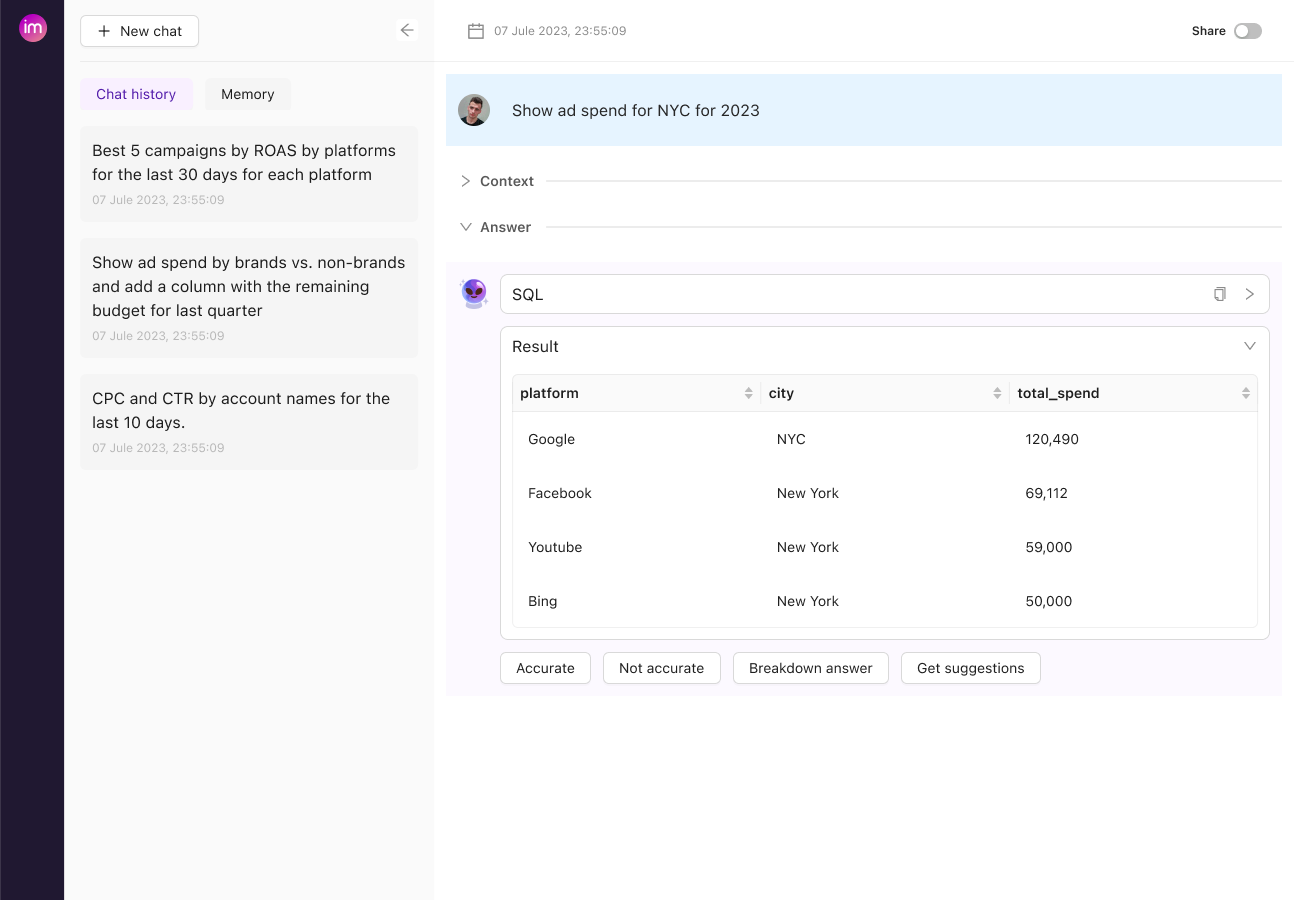Artificial intelligence (AI) and business intelligence (BI) are two technological spheres that, when combined, offer a powerful toolset for transforming raw data into actionable insights and making data accessible to everyone. This synergy allows businesses to navigate vast data landscapes efficiently, making informed decisions swiftly.
This guide covers everything from the role and benefits of AI in business intelligence to the first steps you can undertake to integrate AI in your BI processes.
The Role of AI in Business Intelligence
The Advantages of AI in BI for Companies
The integration of AI and business intelligence (BI) is revolutionizing how companies operate, offering a multitude of advantages that propel them towards more efficient, informed, and agile business practices. Here are some of the key benefits that AI brings to the table.
Data made accessible to non-technical users
It's by far the biggest change the introduction of AI to BI has brought.
Traditionally, marketers and other specialists without the technical background had to rely heavily on data analysts for research and analysis, as navigating complex data sets and tools was out of their scope. However, AI is shifting this dynamic, democratizing data access and analysis.
This tailored approach significantly reduces the dependency on specialized data teams and allows for quicker, more autonomous decision-making across the board. AI, in essence, is making data less about numbers and more about insightful stories that every team member can read and understand, thereby enhancing the overall efficiency and strategic capability of the organization.
Enhanced forecasting accuracy
AI algorithms excel at pattern recognition, sifting through historical data to identify trends that humans might overlook. This capability leads to more accurate predictions about market movements, customer behavior, and inventory requirements. For instance, AI can analyze seasonal buying patterns to forecast demand for products, enabling companies to optimize their inventory levels and reduce waste.
Rapid response to market changes
The speed at which AI systems can process and analyze data means that companies can respond to market changes much faster than before. AI-powered BI tools can monitor real-time data streams from various sources, alerting decision-makers to significant events that could affect their business, allowing for swift strategic adjustments.
Consistency in decision-making
AI helps maintain consistency in decision-making processes. Unlike humans, who may be influenced by biases or fluctuating levels of performance, AI systems can provide steady, reliable analysis and recommendations based on the data they are fed.
Additionally, dashboards can display data in a manner that's up for interpretation, potentially resulting in various interpretations and decisions across different departments. However, AI processes the data to deliver a clear answer, ensuring consistent results no matter who querying the data or how many times.
Reducing human error
AI can significantly reduce human error. Even the most diligent and experienced professionals can make mistakes, but AI systems, when properly designed and implemented, operate with a high degree of precision.
Broad business needs support
AI can support a wide range of business needs, from automating business processes and analyzing data for insights to engaging customers and employees more effectively.
Enhancing competitive advantage
The use of AI in BI provides companies with a competitive advantage. The insights gained from AI analytics enable businesses to make smarter investments, improve their operations, and offer better customer experiences than their competitors.
AI vs. Traditional Business Intelligence
Business intelligence has traditionally been a retrospective analytical approach, while artificial intelligence introduces a predictive and prescriptive dimension to data analysis. This comparison explores the nuanced differences between the two, highlighting how each serves unique purposes in the business environment.
Descriptive analytics: The bedrock of BI descriptive analytics in BI
- Focus: Historical data analysis
- Function: Reporting on past performance
- Tools: Standard reporting, dashboards, and scorecards
- Outcome: Insight into past business activities
Predictive analytics: The AI advantage
- Focus: Future outcomes and trends
- Function: Forecasting and trend spotting
- Tools: Machine learning models, data mining
- Outcome: Predictions about future events
Prescriptive Analytics: AI's Proactive Approach
- Focus: Advising on possible outcomes
- Function: Recommending actions based on predictions
- Tools: Simulation algorithms, optimization models
- Outcome: Actionable recommendations for decision-making
| Feature | Traditional Business Intelligence | AI-Enhanced Business Intelligence |
|---|---|---|
| Data Handling | Structured data from internal sources | Structured and unstructured data from diverse sources |
| Analysis Type | Descriptive (What happened?) | Predictive (What will happen?) and Prescriptive (What should we do?) |
| Decision-Making | Reactive based on past data | Proactive with future predictions |
| Reporting | Periodic reports and dashboards | Real-time insights and forecasts |
| User Interaction | Static queries and predefined reports | Dynamic interaction with natural language processing |
| Complexity of Data | Limited complexity, often manual interpretation | Complex data sets automatically analyzed |
| Speed of Insight | Dependent on reporting cycles | Near-instantaneous analytical processing |
| Scope of Insight | Narrow focus on specific KPIs | Broad focus encompassing a range of potential outcomes |
| Innovation | Incremental improvements based on past trends | Continuous learning and adaptation to new patterns |
The complementary nature of BI and AI
While traditional BI provides the groundwork for understanding historical business performance, AI in BI complements this by offering foresight and strategic guidance. The integration of AI into BI practices doesn't replace the need for traditional methods but rather enhances them, providing a more comprehensive view of both past performance and future potential.
Strategic Implementation of AI in Business Intelligence
Integrating AI into business intelligence requires a well-crafted plan, the selection of suitable tools, and a commitment to data integrity. The following steps outline how to ensure that AI implementation not only integrates seamlessly with existing systems but also drives the business forward.
1. Assessing business needs and goals
The first step in implementing AI in BI is to conduct a thorough assessment of business needs and goals. Understanding what the business aims to achieve with AI will guide the selection of tools and the design of the implementation plan.
Here are key questions to streamline the decision-making process:
- What specific business problems are we aiming to solve with AI in BI Is it to enhance data analysis, improve forecasting accuracy, or automate certain BI processes?
- Which areas of our business can benefit the most from AI integration? Are there particular departments or functions, such as marketing, sales, or operations, that will see immediate improvements?
- What type of data do we have, and how can AI help in analyzing it? Do we deal with large volumes of unstructured data that require advanced processing capabilities?
- What is our current BI capability, and how does AI complement or enhance it? Are we looking to augment existing BI tools with AI, or do we need a new solution that combines both?
- How will AI in BI align with our overall business strategy? Does the integration support long-term goals like market expansion, customer experience enhancement, or cost reduction?
- What is the expected ROI from integrating AI into our BI processes? How do we measure success, and what are the key performance indicators?
Selecting the right AI tools
Choosing the right AI tools is critical. The market offers a wide range of AI-powered BI solutions, each with its own set of features and capabilities. Businesses must select tools that align with their specific requirements, such as data visualization, predictive analytics, or natural language processing.
Ensuring data quality
AI systems are only as good as the data they process. Ensuring high data quality is essential for the success of AI in BI. This means establishing processes for data collection, cleaning, and management to maintain accurate and up-to-date datasets.
Integrating AI with existing BI systems
Integration is a key challenge when implementing AI in BI. The new AI tools must work seamlessly with existing BI systems and data infrastructure. This may require technical expertise to ensure compatibility and minimal disruption to ongoing operations.
Training and development
Employees need to be trained to work with AI-enhanced BI systems. This involves not only technical training but also developing an understanding of how AI can complement human decision-making.
Integrating AI into BI systems can raise several concerns:
- Many employees worry that AI tools might be too complex to understand and use effectively. Ensure that the AI tools integrated into the BI system have user-friendly interfaces. Offer comprehensive training sessions that demystify AI for non-technical staff.
- There's a fear that AI might replace human intuition and judgment, which are crucial in marketing. Communicate clearly that AI is meant to complement, not replace, human decision-making. Showcase how AI can enhance human intuition with data-driven insights.
- To address concerns about the financial investment required for implementing AI in BI systems, highlight long-term savings and efficiency gains that outweigh initial costs.
- Skepticism about the accuracy and reliability of insights generated by AI compared to traditional methods is another common challenge. Use pilot programs to demonstrate the accuracy and added value of AI-generated insights.
Monitoring and continuous improvement
After implementation, it is important to monitor the performance of AI in BI systems and make continuous improvements. AI models may need to be refined, and processes adjusted to ensure that the business is deriving maximum value from its investment.
How Can You Start?
Improvado introduces AI Agent, a brand new way to analyze marketing performance. It's a chat-like platform where you can ask any analytics-related questions using natural language and receive immediate insights. The assistant translates your questions into SQL and queries your dataset to provide you with an answer or report.

You can ask the Agent anything like:
- Show how we are pacing with ad spend across our target geographies.
- Show me the top 5 campaigns that generated the highest ROI in the current quarter.
- Which campaigns in Google and Bing came with the highest CPA over the last 90 days?
- Compare conversion rates on Google Ads between October and September 2023.
These are all questions actual users ask AI Agent.
Once you have your answer, you can continue your conversation with the Agent and ask it to interpret results, provide more granular data or campaign advice.
AI Agent is powered by a custom large language model (LLM) similar to ChatGPT and text-to-SQL technology that enables the assistant to interpret natural language to query your data and provide insights.
Such an approach to marketing data analysis significantly reduces the need for complex queries and coding, making data more accessible to non-technical users.
.png)
.jpeg)



.png)
